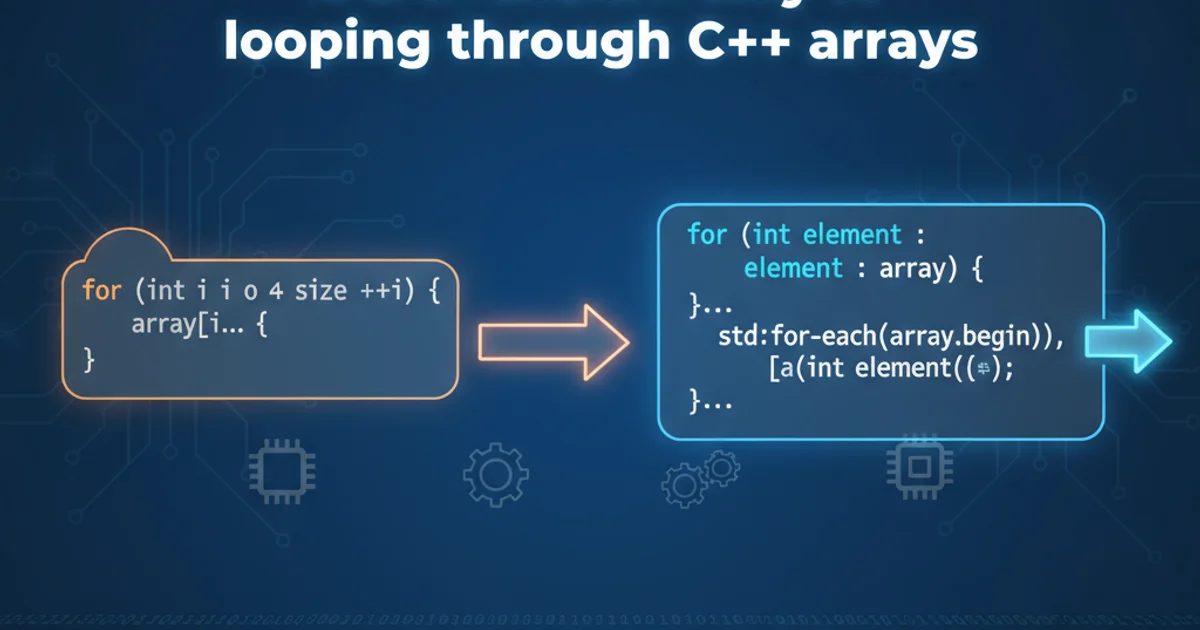more modern way of looping through C++ arrays
Categories:
Modern C++ Array Iteration: Beyond Traditional Loops

Explore modern C++ techniques for looping through arrays, focusing on range-based for loops and standard library algorithms for cleaner, safer, and more expressive code.
Before C++11, iterating over arrays and containers often involved manual index management or iterator pairs, which could be verbose and error-prone. With the introduction of C++11 and subsequent standards, more modern, safer, and expressive ways to loop through arrays have emerged. This article delves into these contemporary methods, highlighting their benefits and providing practical examples.
The Range-Based For Loop (C++11)
The range-based for loop, introduced in C++11, provides a concise and readable way to iterate over all elements in a range (like an array or a standard library container). It automatically handles the iteration mechanics, reducing boilerplate code and the risk of off-by-one errors.
#include <iostream>
#include <vector>
int main() {
// C-style array
int arr[] = {1, 2, 3, 4, 5};
std::cout << "Iterating C-style array:\n";
for (int x : arr) {
std::cout << x << " ";
}
std::cout << "\n\n";
// std::vector
std::vector<double> vec = {10.1, 20.2, 30.3};
std::cout << "Iterating std::vector:\n";
for (double d : vec) {
std::cout << d << " ";
}
std::cout << "\n\n";
// Modifying elements (using reference)
std::cout << "Modifying elements in array:\n";
for (int& x : arr) { // Note the '&' for reference
x *= 2;
}
for (int x : arr) {
std::cout << x << " ";
}
std::cout << "\n";
return 0;
}
Example of range-based for loops with C-style arrays and std::vector.
const auto& for read-only iteration to avoid unnecessary copies and ensure efficiency, especially with complex types. Use auto& when you intend to modify the elements.flowchart TD
A[Start Iteration] --> B{Is there a next element?}
B -->|Yes| C[Get next element]
C --> D[Process element]
D --> B
B -->|No| E[End Iteration]
subgraph Traditional Loop
F[Initialize Index/Iterator] --> G{Check Condition}
G -->|True| H[Access Element by Index/Iterator]
H --> I[Process Element]
I --> J[Increment Index/Iterator]
J --> G
G -->|False| E
end
subgraph Range-Based For Loop
K[Implicitly Get Begin/End Iterators] --> L{Iterate through range}
L -->|Element available| M[Process Element]
M --> L
L -->|No more elements| E
endComparison of iteration flow between traditional and range-based for loops.
Standard Library Algorithms (C++11 and beyond)
For more complex operations than simple iteration, the C++ Standard Library provides a rich set of algorithms (e.g., in <algorithm>, <numeric>) that operate on ranges defined by iterators. These algorithms are highly optimized, expressive, and prevent common programming errors. They often work seamlessly with arrays by using std::begin() and std::end().
#include <iostream>
#include <vector>
#include <numeric> // For std::accumulate
#include <algorithm> // For std::for_each, std::transform
int main() {
int arr[] = {1, 2, 3, 4, 5};
std::vector<int> vec = {10, 20, 30, 40, 50};
// Using std::for_each to print elements
std::cout << "Using std::for_each on array:\n";
std::for_each(std::begin(arr), std::end(arr), [](int x) {
std::cout << x << " ";
});
std::cout << "\n\n";
// Using std::accumulate to sum elements
long long sum = std::accumulate(std::begin(vec), std::end(vec), 0LL);
std::cout << "Sum of vector elements: " << sum << "\n\n";
// Using std::transform to modify elements and store in a new vector
std::vector<int> transformed_vec(vec.size());
std::transform(std::begin(vec), std::end(vec), std::begin(transformed_vec),
[](int x) { return x * 10; });
std::cout << "Transformed vector elements:\n";
for (int x : transformed_vec) {
std::cout << x << " ";
}
std::cout << "\n";
return 0;
}
Examples of using std::for_each, std::accumulate, and std::transform with arrays and vectors.
<algorithm>, <numeric>, and <functional>.Choosing the Right Approach
While traditional for loops with index variables are still valid, modern C++ offers more idiomatic and safer alternatives. The choice depends on the specific task:
- Range-based for loop: Ideal for simply iterating over all elements in a collection, whether for reading or modifying, when the index is not explicitly needed.
- Standard Library Algorithms: Best for common operations like searching, sorting, transforming, filtering, or aggregating elements. They are often more efficient and less error-prone than manual loops.
- Traditional
forloop: Still useful when you need precise control over the iteration, such as iterating only a portion of the array, iterating backwards, or when the index itself is part of the logic (e.g., accessing elements atiandi+1).
flowchart TD
A[Task: Iterate over array/container] --> B{Need element index?}
B -->|Yes| C{Need precise control (e.g., partial iteration, backward)?}
C -->|Yes| D[Traditional `for` loop]
C -->|No| E[Range-based `for` loop (if index is only for access)]
B -->|No| F{Common operation (e.g., sum, sort, transform, find)?}
F -->|Yes| G[Standard Library Algorithm]
F -->|No| H[Range-based `for` loop]Decision tree for choosing an array iteration method in modern C++.